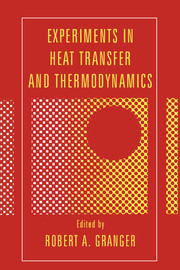Book contents
- Frontmatter
- Contents
- Preface
- Introduction
- Part I Experiments in heat transfer
- I.1 Conduction
- I.2 Convection
- I.3 Boiling
- I.4 Mixing, dispersion, and diffusion
- I.5 Radiation
- I.6 Heat pipes and exchangers
- Part II Experiments in thermodynamics
- Appendix 1 Experiments and demonstrations in thermodynamics
- Appendix 2 Experiments and demonstrations in heat transfer
- Appendix 3 Heat-transfer and thermodynamic films
- Index
Part II - Experiments in thermodynamics
Published online by Cambridge University Press: 05 June 2012
- Frontmatter
- Contents
- Preface
- Introduction
- Part I Experiments in heat transfer
- I.1 Conduction
- I.2 Convection
- I.3 Boiling
- I.4 Mixing, dispersion, and diffusion
- I.5 Radiation
- I.6 Heat pipes and exchangers
- Part II Experiments in thermodynamics
- Appendix 1 Experiments and demonstrations in thermodynamics
- Appendix 2 Experiments and demonstrations in heat transfer
- Appendix 3 Heat-transfer and thermodynamic films
- Index
Summary
Thermodynamics is one of the major branches of physics. It is concerned with the behavior of energy as affected by changes of temperature. In particular, thermodynamics explains the observed properties of matter at any temperature. In this connection, we might consider heat capacities, magnetic and electrical effects, phase transitions, and higher-order transitions (such as the Ehrenfest third-order transition) as principle topics.
Classical thermodynamics on the other hand treats the many observable properties of solids and fluids in such a manner that they can all be viewed as a consequence of a few. The four laws of thermodynamics are the result of observation: thus the importance of experimentation in this science. The development of the four laws is elegant. The laws contain an aesthetic spirit that once grasped and understood by the student will stand as the undercurrent for all the other physical sciences.
To tickle the student's imagination consider the application of thermodynamics to one aspect of the study of black holes. It is known a black hole has entropy. For example, the area of the event horizon of a black hole is entropy. Adding mass to a black hole increases the event horizon since it has added entropy. If the black hole has entropy it has temperature, which means black holes can radiate energy. The question arises how can black holes (possessing temperature) emit particles of radiant energy if nothing can escape past the event horizon?
- Type
- Chapter
- Information
- Experiments in Heat Transfer and Thermodynamics , pp. 201 - 204Publisher: Cambridge University PressPrint publication year: 1994



